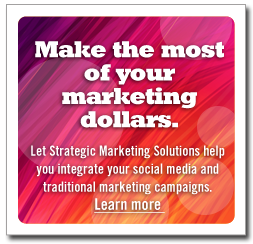Because I’m a loyal customer, I experience Starbucks brand marketing on a frequent basis, benefiting from their customer loyalty program and best practices in marketing.
Starbucks is a master of integrated multi-channel marketing; in today’s example, my rewards reminder came to me through two touchpoints. In my inbox, I have an email from Starbucks telling me I am now eligible for my next free reward.
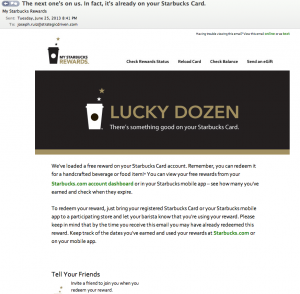
I am also aware because I can track my reward status through the mobile app.
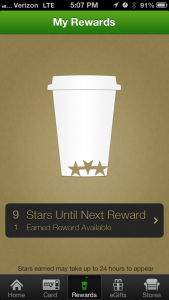
Customer Loyalty Programs have a long history
Loyalty programs have been in the marketing toolbox for a long time. One of the most obvious examples is a airline frequent flyer program. Most everyone is familiar with the way these programs work. Airlines invite customers to join a program, and then flight miles are recorded and redeemed for awards like free trips and merchandise depending on the number of miles and the program.
Airlines often create programs to reward more frequent travelers. In addition to earning free travel these premier segments offer better travel experiences with service upgrades, special lounges
According to Maritz Loyalty Marketing’s December 2012 survey, US Internet users participated in an average of 7.4 loyalty programs last year. A recent emarketer article created a table showing the participation by categories.
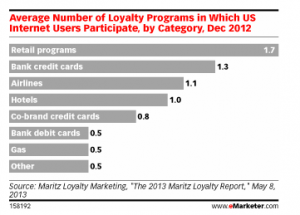
Based on the survey findings a clear majority of consumers (8 out of 10) feel there is value in participating in loyalty rewards programs. A substantial portion of these consumers felt these programs were a part of their relationship to the brand and more than half indicated these programs affected their purchasing behavior.
Loyalty Program Concerns
Although the vast majority of consumers participate in reward programs there are those who have concerns about certain aspects of these programs. The primary issues are related to practices that raise privacy concerns.
In the emarketer article “To Keep Users Happy, Loyalty Programs Must walk a fine line” emarketer identified a list of “creepy/weird” ways programs use personal information .
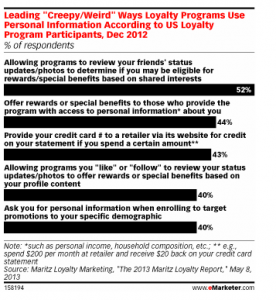
While some of these practices may seem harmless enough marketers have to remember that loyalty programs are essentially transaction programs. Sure these programs can positively influence purchase behavior company’s must always view these relationships from the consumer’s perspective. This is especially important when offering benefits in exchange for any type of personal information, and this includes access to friends.
Customer Loyalty Program Best Practices
I’ll use the Starbuck’s example to highlight a few important best practices.
First the program is relatively simple. The primary benefit is a free drink after purchasing twelve. They keep track of how many purchases so I don’t have to. I can check on my progress through my web account or mobile app.
Redemption of the rewards should be straightforward. Some airlines programs will be more complicated by virtue of the type of experience. In general less complicated is better.
Provide redemption options. I receive post cards, email and notifications through my mobile app. I can use any of these to redeem my free drink.
Use personal information sparingly and appropriately. I do receive a free drink on my birthday each year. I provide the month and day when signing up.
Encourage consumers to share their experience by making the process easy and subtle.
One cautionary note, think carefully about the rewards you offer, make sure the offering is sustainable. A while back Starbucks took aware several benefits creating quite a stir. Consumers never like to have a brand take away a perceived benefit.
I enjoy learning from marketing best practices and mistakes in my everyday transactions and routines. What brand encounters are currently benefiting you? Or are there some you’d rather do without? I’d love to hear about them.

